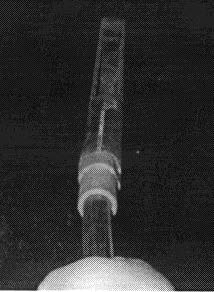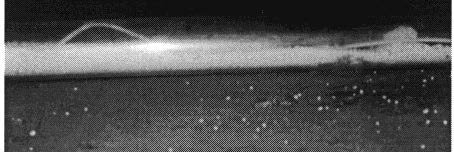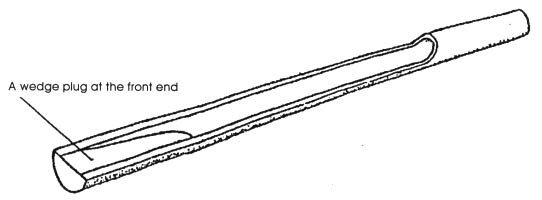Underground Perimeter Control Basics: Perimeter Control Products
Perimeter Control Explosives Products and Initiation Systems
This post focuses on various types of perimeter control products that are available on most markets. The range of products covered in this article include packaged emulsion-based trim powder, nitroglycerin-based trim powder, bulk product applications, detonating cord, and a combination of more than one of these products. The post also covers basic differences between nonelectric and electronic initiation systems and how each type of system can impact perimeter control performance.
As discussed in a previous post, perimeter control blasting methods use a combination of design tools. These include decoupling, reducing explosive energy, and improving delay accuracy, which are basically the primary levers focusing on product selection that you can pull to affect perimeter control performance. This post focuses more on development and burn cut blasting perimeter control; however, nearly everything in the article applies to underground longhole blasting and surface blasting.
Packaged Emulsion-Based Trim Products
The majority of trim powder that most mines use in my experience is packaged emulsion trim powder. Storage and handling for packaged emulsion products usually do not require extra magazines or safety precautions because most operations can already carry emulsion products. Typically plastic film trim powder is easier to load down hole than in horizontal development holes, but it can be used in either application.
Image: Packaged emulsion trim product. Note: this was found post-blast so it obviously ejected from the hole. It is important to ensure proper loading techniques so that this does not happen.
Emulsion trim products are typically packaged in plastic film; however, emulsion products can also be purchased in paper wrapped cartridges. Typically, the diameter ranges from around 1 inch (25 mm) up to 1.5 inches (38 mm) for development blasting. Larger package diameters are available for blasting with larger hole diameters. The length of trim products can vary from short chubs up to around 15 ft (4.6 m). The longer products help ensure continuity along the charge length, but care must be taken to massage the emulsion so that there are no crimps or gaps from folding in the box.
Emulsion trim products, similar to other small diameter packaged emulsion products are detonator sensitive. It may be good practice to use a small cast booster to prime the trim product. Cast boosters provide more energy and reduce the chance of the detonator being “disconnected” from the emulsion trim product while the rest of the blast is detonating. It may be also worth lining the trim powder with detonating cord, depending on the strength of the cord.
Typically, technical specification sheets can be downloaded from your supplier’s website. These sheets will provide the charge weight per length, density, diameter and length combinations that are available. The tech spec sheets will also state if you need to trace with detonating cord and the minimum cord strength required to side-initiate the product you’re using. Most technical specification sheets will state that you need to contact y our local representative for any specific application questions that you may have.
Note that if you desire a significant volume of product that is not standard, explosive manufacturers may be able to produce a run of product that is specific to your needs.
Nitroglycerin-Based Trim Products
If your site allows nitroglycerin (NG)-based explosives, then there are trim products available on the market that you could consider. The main reason some operators do not allow NG products is due to additional safety requirements for handling and storage.
Image: Nitroglycerin-based paper wrapped trim powder.
Typically, NG products have a smaller minimum diameter of around 7/8 inch (22 mm). Since one of the most important design perimeters for perimeter control is decoupling, NG products may provide a better decouple ratio than emulsion products.
Another benefit is that the NG products are typically manufactured in paper cartridges. This means the product is more rigid and shorter (for example: 2 ft (0.6 m)) than packaged emulsion. One benefit is that the cartridges don’t come folded in the box. There is no need to massage the product to reduce the gaps and emulsion typically has better gap sensitivity. However, there could be issues detonating from cartridge to cartridge, so detonating cord likely needs to be traced along the product. Your manufacturer’s specification sheets may recommend detonating cord for charges over a certain length.
When priming, it is important to ensure the detonator is placed in the center of the end of the cartridge so that it is in contact with the explosive in the cartridge. There should not be a need to use primers; however, one can use them if they are properly coupled to the cartridge.
One other benefit to the rigid, paper wrapped cartridges is that they are easier to load in small diameter development rounds than packaged emulsion products.
Bulk Product Applications
In some cases, bulk products can be applied as perimeter control. However, care must be taken to ensure the bulk products are adequately decoupled and/or gassed to reduce the energy along the perimeter. Bulk products can be used for perimeter control through string loading (leaving a bead of bulk explosive along the bottom of perimeter holes), tracing with detonating cord, diluting bulk products, and decoupling with plastic liners. String loading is only applicable in horizontal development holes. The other methods can be used in horizontal holes or vertical holes.
A published study by an explosives manufacturer compared packaged perimeter control product performance to bulk emulsion that was gassed and decoupled. The bulk emulsion was gassed from a density of 1.2 g/cc to a density of around 0.9 g/cc. The emulsion was also string loaded at a 65% coupling ratio. Theoretical calculations using the recorded VOD, density, and decoupling ratio showed that the string loaded and gassed bulk emulsion produced a similar, if slightly higher, borehole pressure and damage radius to that of packaged emulsion. The study was intended to show that packaged emulsion can be replaced by properly applied bulk emulsion to produce similar blast results while helping reduce loading times by eliminating the need for packaged product.
Image: String loading and gassing results from study. Source: N. Rouse, 2022. “Rethinking Underground Perimeter Control Using Modern Technologies.” Brazil UFRGS Chapter of the ISEE.
ANFO can be “spoon” loaded, using a wedge in the base of an ANFO hose to reduce the amount of ANFO in the blasthole to around 30%. The air pressure is also reduced to ensure an even amount of ANFO is loaded along the hole.
Images: Loading hose end view of spoon, typical powder section in plexiglass tube resulting from spoon loading, and spoon section showing principal features. Source: McDonald, K. and L. Ng, 1994, “ Perimeter Blasting with the ANFO-Spoon Technique.” ISEE.
Bulk products can be traced with a low strength detonating cord. The idea behind this approach is that the detonating cord, which detonates faster than the bulk explosive, is weak enough that it will not side-initiate the explosive. It will damage the explosive immediately surrounding the detonating cord so that a fraction of the explosive in the bulk explosive detonates or deflagrates.
Some products can be diluted with inert material. For example, some explosive providers supply low-density or reduced-energy ANFO by mixing it with inert material. This material will reduce the available energy of the ANFO, thus providing some protection for the final wall.
Finally, bulk explosive products can be loaded in plastic film or tubes in a blasthole. This allows an operator to use bulk explosive in every blasthole. The film or tube will provide some decoupling to reduce the energy the the explosive can impart on the final wall around the blast.
There are some other methods as well, such as air decking. This method will be discussed in a later post.
Detonating Cord
Image: Detonating cord. Source: Dyno Nobel
A rule of thumb for perimeter control design is that the explosive diameter should be around 25% of the hole diameter. The downside with underground development blasting is that most perimeter control explosive products are too large to meet this requirement. Sometimes, the only explosive that can meet the decoupling ratio requirement is detonating cord. Detonating cord may be a more expensive option, but it does allow a blast to follow the 25% decoupling rule of thumb.
Detonating cord is typically available up to 400 grain per foot (85 gram per meter) which has a diameter of 0.4 in (10 mm). 0.4 inches is around 25% of the smaller range of underground development blasting drillhole diameters. So it is a viable solution if a site uses small diameter blastholes in development rounds. Detonating cord can also be doubled up to provide greater charge weight and coupling if required.
The benefit of detonating cord is that there is typically no concern with gaps because it is cut to any desired length from a long roll. It also has a high detonation velocity.
Combination
Image: Detonating cord-traced trim powder. Source: Orica
Combining detonating cord with trim products or bulk products has been mentioned above for a couple of different reasons. Detonating cord can be combined in two ways: (1) to side initiate trim product so that there are no concerns with gaps in the powder or (2) to purposefully damage bulk product so that less energy is imparted into the perimeter when the bulk explosive fires.
Some products come pre-traced with detonating cord. These products are usually premium trim products.
Tracing with detonating cord is a practice that must be be carefully considered prior to application. The strength of the detonating cord is important for either method of tracing. Make sure to with the local powder company representative to understand the product you are tracing and what different strengths of detonating cord will do to the product when they’re initiated.
Initiation Systems
Today, there are two types of initiation systems: pyrotechnic (nonelectric) and electronic. Pyrotechnic delays have a significant amount of cap scatter (difference between nominal delay when they are designed to detonate and when they actually detonate). Because pyrotechnics have cap scatter, underground nonelectric detonators have long delay periods so each delay fires in the correct order. Underground blasts that use nonelectric detonators typically take over 10 seconds to fully detonate. The perimeter holes typically shoot on the last delays, so care must be taken to ensure they detonate in the order they are designed to detonate. Sometimes, it is difficult to achieve good perimeter control due to the cap scatter, especially in weak rock.
Electronic detonators have practically no cap scatter, so they detonate exactly when they are designed to detonate. Obviously, there is an additional cost associated with electronic detonators. However, when perimeter control is of utmost importance, the accuracy of electronic detonators cannot be overlooked.









